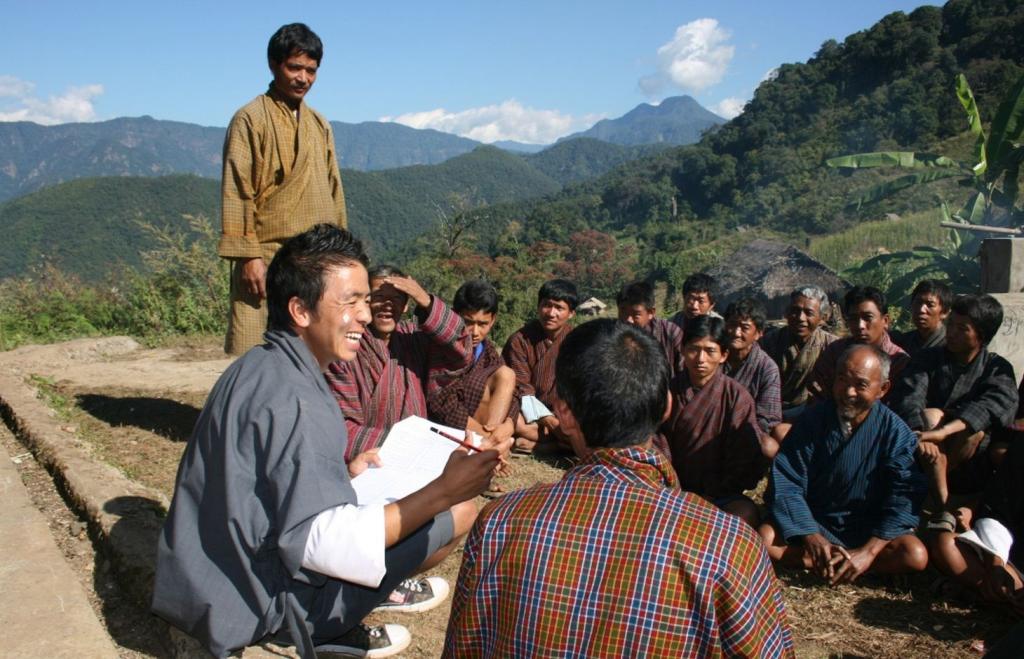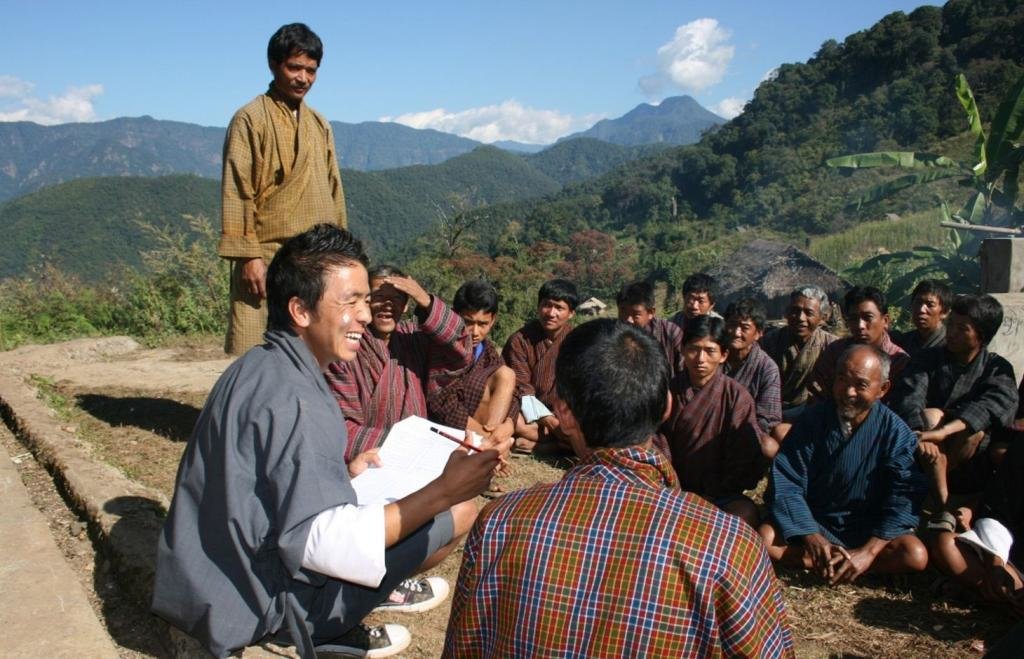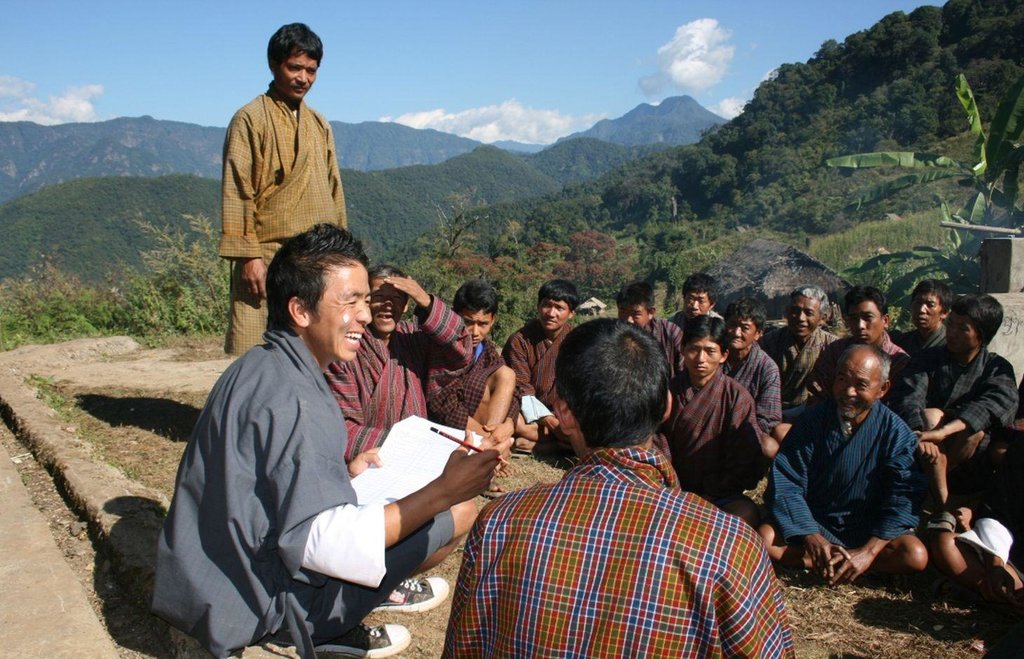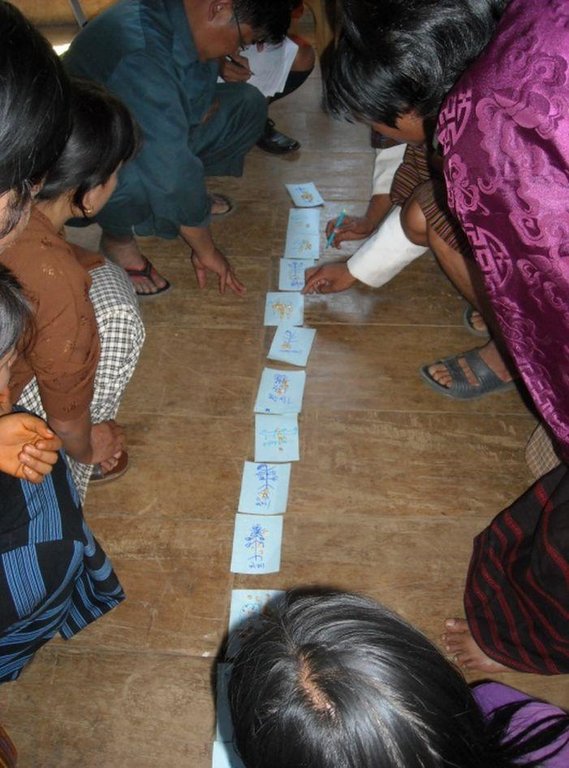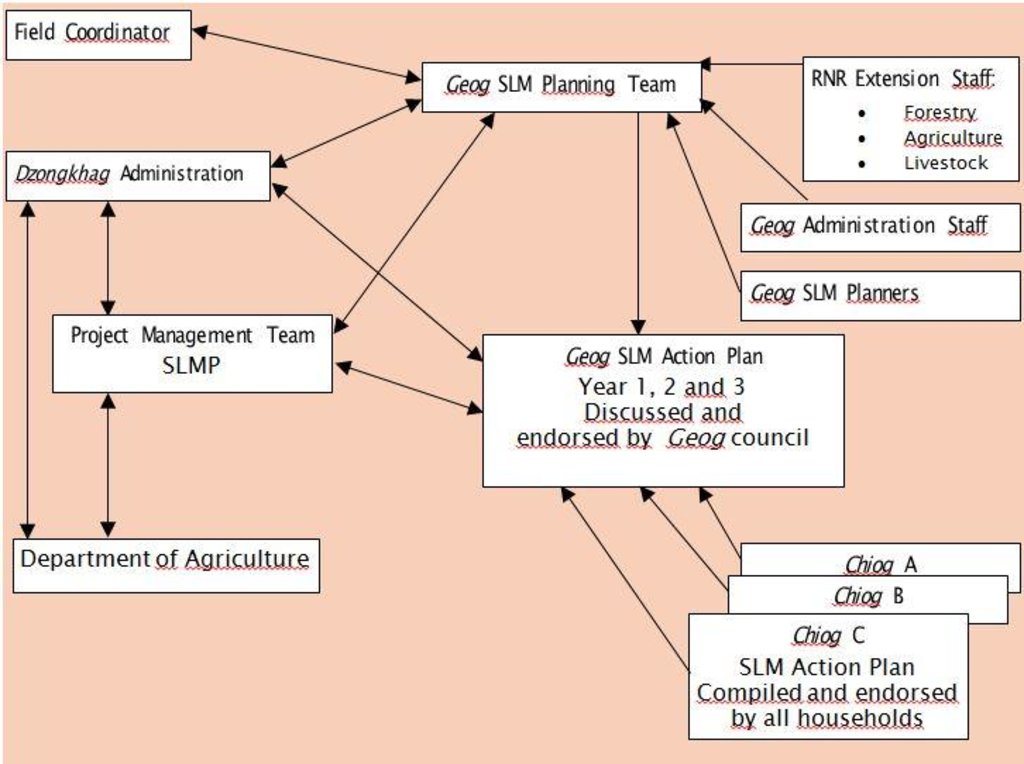Participatory SLM Action Planning [Bhoutan]
- Création :
- Mise à jour :
- Compilateur : Karma Dorji
- Rédacteur : –
- Examinateur : Fabian Ottiger
approaches_2489 - Bhoutan
Voir les sections
Développer tout Réduire tout1. Informations générales
1.2 Coordonnées des personnes-ressources et des institutions impliquées dans l'évaluation et la documentation de l'Approche
Spécialiste GDT:
Wangdi Tashi
NSSC, DoA, MoAF, RGoB
Bhoutan
Spécialiste GDT:
Dorji Tshering
NSSC, DoA, MoAF, RGoB
Bhoutan
Nom du ou des institutions qui ont facilité la documentation/ l'évaluation de l'Approche (si pertinent)
National Soil Services Centre (National Soil Services Centre) - BhoutanNom du ou des institutions qui ont facilité la documentation/ l'évaluation de l'Approche (si pertinent)
MoA (MoA) - Bhoutan1.3 Conditions relatives à l'utilisation par WOCAT des données documentées
Quand les données ont-elles été compilées (sur le terrain)?
14/03/2011
Le compilateur et la(les) personne(s) ressource(s) acceptent les conditions relatives à l'utilisation par WOCAT des données documentées:
Oui
2. Description de l'Approche de GDT
2.1 Courte description de l'Approche
A methodology to identify in a participatory manner at village level land-based problems, its causal factors and mitigation measures to reduce land degradation and enhance rural livelihoods
2.2 Description détaillée de l'Approche
Description détaillée de l'Approche:
Aims / objectives: Participatory SLM Action Planning (SLM AP) is a methodology that aims at prioritiz-ing possible SLM interventions to mitigate the most critical land degradation issues. Priorities are based on the identification of land-based livelihoods and livelihood resources, the key area-based problems and their causes. SLM AP is carried out in the SLMP geogs (block) at chiog (village) level, including all community households. It involves elements of PRA/PLA such as problem census, cropping calendars, history lines, natural resource mapping and builds on the in-depth knowledge and understanding of farming households of their land, their problems and opportunities. The process is highly visual to include the illiterate and very interactive by giving the communities the lead in prioritizing their problems and deciding on SLM interventions.
Methods: The SLM AP is an iterative process, starting with building and training SLM planning teams (GSPTs) at geog level, comprising of extension staff and locally recruited geog SLM planners (GSPs) and geog administration staff. The GSPTs start awareness and mobilization activities in the first year at geog council level. This is followed by a 3 day SLM AP in each and every chiog of the geog to compile a chiog SLM action plan. The village SLM APs are combined into a geog SLM AP and discussed, amended and endorsed in a public meeting by the geog council. The necessary budget is allocated by SLMP project and implementation of the planned activities takes place at chiog level.
Stages of implementation: Implementation is preceded by intensive training and capacity building of the communities in SLM activities. In the second year a new SLM AP round is made, lasting only one day, with review of the previous SLM AP at chiog level. Potential new activities are identified, based on field experiences, to complete the new SLM AP for year 2. In the final year 3, a last SLM AP round is made in all chiogs to compile chiog and ultimately a geog SLM AP.
Role of stakeholders: SLM AP is an inclusive process and gender sensitive, with focus on vulnerable households. The approach includes participatory Natural Resource mapping at chiog level and participatory Monitoring & Evaluation to track implementation progress and impact and to get feedback of the communities.
Other important information: Environmental and social screening procedures are applied to exclude any negative impact on the land or on social groups. SLM AP was piloted in 3 geogs in 3 Dzongkhags since 2006 and has been rolled out to more than 130 chiogs in 9 geogs.
2.3 Photos de l'approche
2.5 Pays/ région/ lieux où l'Approche a été appliquée
Pays:
Bhoutan
Région/ Etat/ Province:
Chhukha, Trashigang and Zhemgang Dzongkhags
Autres spécifications du lieu :
9 separate geogs
2.6 Dates de début et de fin de l'Approche
Indiquez l'année de démarrage:
2006
Date (année) de fin de l'Approche (si l'Approche n'est plus appliquée):
2012
2.7 Type d'Approche
- fondé sur un projet/ programme
2.8 Principaux objectifs de l'Approche
The Approach focused mainly on SLM with other activities (livelihoods, cash income, food security, capacity building, awareness raising)
- To build community capacity to assess land degradation and identify and prioritize mitigation measures
- Enhancement of rural livelihoods
The SLM Approach addressed the following problems: - Lack of awareness of land degradation processes, combined with limited technical knowledge to tackle its causes.
- Planning procedures are top-down and do not incorporate land-based issues adequately and fail to build local ownership and sustainability.
2.9 Conditions favorisant ou entravant la mise en œuvre de la(des) Technologie(s) appliquée(s) sous l'Approche
disponibilité/ accès aux ressources et services financiers
- entrave
Large amount of cash to handle at municipality level
Treatment through the SLM Approach: Training, monitoring and limitation of cash amounts
cadre institutionnel
- entrave
Delays in financial releases to decentralised level because of lengthy/complicated administrative chain
Treatment through the SLM Approach: Training of key financial staff to shorten procedure and minimize frequency of budget releases
cadre juridique (régime foncier, droits d'utilisation des terres et de l'eau)
- favorise
The existing land ownership, land use rights / water rights helped a little the approach implementation: Individual land titles of households favour greatly the planning and implementation of SLM activities
- entrave
Lack of efforts in implementing SLM technologies on land without ownership and living as tenants
Treatment through the SLM Approach: Awareness on the importance of proper management to prevent decline in productivity and their own livelihoods through loss of soil fertility and or loss of land physically due to landslides and mass movements.
connaissances sur la GDT, accès aux supports techniques
- entrave
Awaraness of communities and technical confidence of teams
Treatment through the SLM Approach: Training and capacity buidling
charge de travail, disponibilité de la main-d'œuvre
- entrave
Large volume of work, especially in growing season
Treatment through the SLM Approach: Make of use of lean winter season for labour-intensive SLM interventions
autre
- entrave
Small land holding sizes to spare a portion for SLM technologies
Treatment through the SLM Approach: Awareness on the advantages of SLM
3. Participation et rôles des parties prenantes impliquées dans l'Approche
3.1 Parties prenantes impliquées dans l'Approche et rôles
- exploitants locaux des terres / communautés locales
communities of all chiogs
In all villages the most vulnerable community members were identified (wealth / well-being ranking), ranked and specific effort made to include them in most interventions, where possible.
- Spécialistes de la GDT/ conseillers agricoles
- enseignants/ élèves/ étudiants
- gouvernement local
GSPT and Dzongkhag staff (Local government)
- gouvernement national (planificateurs, décideurs)
RGoB, MoAF, DoA
- organisation internationale
GEF, World Bank
- monk body
3.2 Participation des exploitants locaux des terres/ communautés locales aux différentes phases de l'Approche
| Participation des exploitants locaux des terres/ communautés locales | Spécifiez qui était impliqué et décrivez les activités | |
|---|---|---|
| initiation/ motivation | interactive | National level stakeholders in consultation with district and municipality staff developed the methodology through an iterative consultation process |
| planification | interactive | Decentralised training and planning of SLM interventions at chiog level (130+ chiogs) in 9 geogs in 3 Dzongkhags |
| mise en œuvre | interactive | Range of SLM and livelihood activities at chiog level (130+ villages) during 6 year project period |
| suivi/ évaluation | interactive | Regular participatory M&E at chiog and geog level |
| Research | passive | Few focused SLM related research topics commissioned to governmental research institutions |
3.3 Diagramme/ organigramme (si disponible)
Description:
Overview of network of Stakeholders at chiog (village), geog and district level
Auteur:
Hans van Noord (Schoutenkamp 43 Heteren The Netherlands)
3.4 Prises de décision pour la sélection de la Technologie/ des Technologies
Indiquez qui a décidé de la sélection de la Technologie/ des Technologies à mettre en œuvre:
- principalement les exploitants des terres soutenus par des spécialistes de la GDT
Expliquez:
Decisions on the method of implementing the SLM Technology were made by mainly by SLM specialists with consultation of land users. The SLM planning was done in a very participatory manner with the land users as they best know the problems in their land i.e. where, how, when, etc. Planning done using participatory planning tools and field visits. Based on the problems at the site (site specific problems) then SLM Specialists make problem specific recommendations of SLM technologies. The main Monitoring and Evaluation was done after every six months when comprehensive information was collected with structured questionnaires along with site visits and meeting with the communities. M&E was also done as frequently as possible even while visiting the site for other purposes during the year without compulsory group meetings.
4. Soutien technique, renforcement des capacités et gestion des connaissances
4.1 Renforcement des capacités/ formation
Une formation a-t-elle été dispensée aux exploitants des terres/ autres parties prenantes?
Oui
Spécifiez qui a été formé:
- exploitants des terres
- personnels/ conseillers de terrain
- Project management staff
Formats de la formation:
- sur le tas
- entre agriculteurs (d'exploitants à exploitants)
- zones de démonstration
- réunions publiques
- cours
Thèmes abordés:
Extensive training programmes for project management staff and field coordinators and the decentralised extension staff (forestry, livestock and agriculture) at geog level together with the geog administration staff and finally to all chiog communities (130+). Initial training was on SLM action planning and Natural Resource mapping; later on a range of technical intervention such as hedgerow establishment, check dam construction, bioengineering, afforestation, community forestry, fodder development, bamboo plantation, bench terracing etc.
4.2 Service de conseils
Les exploitants des terres ont-ils accès à un service de conseils?
Oui
Spécifiez si le service de conseils est fourni:
- dans les champs des exploitants?
Décrivez/ commentez:
Name of method used for advisory service: SLM planning knowledge transfer; Key elements: participatory planning, capacity and skills building of RNR extension staff; Whole range of extension advisory services by all extension teams related to SLM, cash generation and group formation
Advisory service is quite adequate to ensure the continuation of land conservation activities; Capacity built, awareness raised, institutions supported. Adequate human and institutional capacities and awareness have been created during the GEF/World Bank SLM Project period and the effort is still being continued. The actual implementation of the SLM technologies in the field is constrained by inadequate fund support and small land holdings.
4.3 Renforcement des institutions (développement organisationnel)
Des institutions ont elles été mises en place ou renforcées par le biais de l'Approche?
- oui, un peu
Spécifiez à quel(s) niveau(x), ces institutions ont été renforcées ou mises en place:
- local
Précisez le type de soutien:
- renforcement des capacités/ formation
- équipement
- curriculum development support, seeds, seedlings
Donnez plus de détails:
Moderate support to monk body, schools, Non-Formal Education and geog administrations
4.4 Suivi et évaluation
Le suivi et l'évaluation font ils partie de l'Approche? :
Oui
Commentaires:
bio-physical aspects were regular monitored by project staff through observations; indicators: Regular measurements and observations of acreage of improved vulnerable land through SLM interventions; annual soil erosion plot measurements
bio-physical aspects were regular monitored by project staff through measurements; indicators: Regular measurements and observations of acreage of improved vulnerable land through SLM interventions; annual soil erosion plot measurements
technical aspects were regular monitored by project staff through observations; indicators: Regular measurements and observations of acreage and properties of specific areas of improved vulnerable land
technical aspects were regular monitored by project staff through measurements; indicators: Regular measurements and observations of acreage and properties of specific areas of improved vulnerable land
socio-cultural aspects were regular monitored by project staff, land users through observations; indicators: Regular observations through participatory M&E meetings
economic / production aspects were regular monitored by project staff through observations; indicators: Regular observations and measurements by field extension staff (crop cut, animal production, volume of bamboo marketed; CBA study to establish economic viability
economic / production aspects were regular monitored by project staff through measurements; indicators: Regular observations and measurements by field extension staff (crop cut, animal production, volume of bamboo marketed; CBA study to establish economic viability
area treated aspects were regular monitored by project staff, land users through measurements; indicators: Regular measurements of area treated: range of project indicators for vulnerable land improved
no. of land users involved aspects were ad hoc monitored by project staff, government through measurements; indicators: Regular measurements of households and farmers (male/female) participating
management of Approach aspects were regular monitored by None through observations; indicators: WB, MTAC, Regular reviews with key stakeholders (Annual Review Workshops)
There were several changes in the Approach as a result of monitoring and evaluation: Two-tier approach: combination of inclusion of all household combined with limited areal focus; vulnerable households focus; financial disbursement system; ch more cash-generating activities; more group/community focus; labour-saving machinery
There were few changes in the Technology as a result of monitoring and evaluation: change of type and variety of seeds and seedlings
4.5 Recherche
La recherche a-t-elle fait partie intégrante de l’Approche?
Oui
Spécifiez les thèmes:
- sociologie
- économie/ marketing
- écologie
Donnez plus de détails et indiquez qui a mené ces recherches:
Little involvement, apart from some focused research on group formation at chiog level and studies on CBA, SLM-poverty linkage, rangeland management, rural-urban transition etc.
Research was carried out both on station and on-farm
5. Financement et soutien matériel externe
5.1 Budget annuel de la composante GDT de l'Approche
Si le budget annuel précis n'est pas connu, indiquez une fourchette:
- > 1 000 000
Commentez (par ex. principales sources de financement/ principaux bailleurs de fonds):
Approach costs were met by the following donors: international (GEF-World Bank): 70.0%; government (RGoB): 20.0%; local community / land user(s): 10.0%
5.2 Soutiens financiers/ matériels fournis aux exploitants des terres
Les exploitants des terres ont-ils reçu un soutien financier/ matériel pour la mise en œuvre de la Technologie/ des Technologies?
Oui
Si oui, spécifiez le(s) type(s) de soutien, les conditions et les fournisseurs:
Incentives for specific SLM interventions per area and through short-term input support (seeds and seedlings)
5.3 Subventions pour des intrants spécifiques (incluant la main d'œuvre)
- équipement
| Spécifiez les intrants subventionnés | Dans quelle mesure | Spécifiez les subventions |
|---|---|---|
| outils | en partie financé | |
- intrants agricoles
| Spécifiez les intrants subventionnés | Dans quelle mesure | Spécifiez les subventions |
|---|---|---|
| semences | en partie financé | |
| Seedlings | en partie financé | |
- matériaux de construction
| Spécifiez les intrants subventionnés | Dans quelle mesure | Spécifiez les subventions |
|---|---|---|
| for fencing and dams | en partie financé | |
- infrastructures
| Spécifiez les intrants subventionnés | Dans quelle mesure | Spécifiez les subventions |
|---|---|---|
| FYM sheds, irrigation channel renovation | en partie financé | |
Commentaires:
Mostly voluntary and some paid in cash (for labour-intensive SLM interventions) and limited other material support such as tools and seeds and seedlings
Not financed: roads, fertilizers, schools
5.4 Crédits
Des crédits ont-ils été alloués à travers l'Approche pour les activités de GDT?
Non
6. Analyses d'impact et conclusions
6.1 Impacts de l'Approche
Est-ce que l'Approche a aidé les exploitants des terres à mettre en œuvre et entretenir les Technologies de GDT?
- Non
- Oui, un peu
- Oui, modérément
- Oui, beaucoup
Considerable area of vulnerable land brought under SLM, reduction of loss of land, improved yields, improved income, improved animal production, improved fodder base
Est-ce que l'Approche a autonomisé les groupes socialement et économiquement défavorisés?
- Non
- Oui, un peu
- Oui, modérément
- Oui, beaucoup
Moderate improvement of vulnerable households (poorest and single-headed households) through targeted interventions and pro-active inclusion. The labour sharing approach in implementing SLM activities greatly benefited the resource (human and capital) constrained household.
Est-ce que l'Approche a amélioré les questions foncières et des droits d'utilisation qui entravent la mise en œuvre des Technologies?
- Non
- Oui, un peu
- Oui, modérément
- Oui, beaucoup
The problem is unlikely to be overcome in the near future. Individual land titles of households favour greatly the planning and implementation of SLM activities
Did other land users / projects adopt the Approach?
- Non
- Oui, un peu
- Oui, modérément
- Oui, beaucoup
Other government and donor-funded projects have adopted elements of the participatory SLM action planning methodology (DANIDA, REAP)
Did the Approach lead to improved livelihoods / human well-being?
- Non
- Oui, un peu
- Oui, modérément
- Oui, beaucoup
cash income, food self-sufficiency, community sense/bonding, reduced exposure to natural hazards related to land degradation/flooding
Did the Approach help to alleviate poverty?
- Non
- Oui, un peu
- Oui, modérément
- Oui, beaucoup
Improvement of food self-sufficiency and cash generation opportunities
6.2 Principale motivation des exploitants des terres pour mettre en œuvre la GDT
- augmenter la production
- réduire la charge de travail
- paiements/ subventions
- prestige, pression sociale/ cohésion sociale
- affiliation à un mouvement/ projet/ groupe/ réseaux
- conscience environnementale
- well-being and livelihoods improvement
6.3 Durabilité des activités de l'Approche
Les exploitants des terres peuvent-ils poursuivre ce qui a été mis en œuvre par le biais de l'Approche (sans soutien extérieur)?
- incertain
Si non ou incertain, spécifiez et commentez:
Rural communities will need continued support by government staff through advice, finance and other support.
6.4 Points forts/ avantages de l'Approche
| Points forts/ avantages/ possibilités du point de vue du compilateur ou d'une autre personne ressource clé |
|---|
|
Decentralised, village level bottom-up planning and implementation ensures capacity building, ownership and empowerment of rural land users Participatory character gives a voice to farmers with in-depth knowledge of land-based issues and its causes and history Inclusiveness of approach, reaching to all households Helps to build community sense (How to sustain/ enhance this strength: Continued annual AP Continued annual AP; add with NR mapping and ITK studies and participatory M&E Continued annual AP; targeted focus on most vulnerable households Additional group formation and community group support ) |
6.5 Faiblesses/ inconvénients de l'Approche et moyens de les surmonter
| Faiblesses/ inconvénients/ risques du point de vue du compilateur ou d'une autre personne ressource clé | Comment peuvent-ils être surmontés? |
|---|---|
|
Time-consuming and resource demanding Requires large workload of both extension staff and farmers Costly as the approach also covers actual implementation of all of planned SLM activities and reaches more than 130 villages for 3 year period |
Combine and align with Five Year Plan planning procedures; mainstreaming into governmental decentralised planning procedures Mainstreaming into regular planning and budgeting Spread over calendar year; labour-intensive SLM activities in lean winter season. |
7. Références et liens
7.1 Méthodes/ sources d'information
- visites de terrain, enquêtes sur le terrain
- interviews/entretiens avec les exploitants des terres
7.2 Références des publications disponibles
Titre, auteur, année, ISBN:
Working the Land - Documenting the Key Lessons of Sustainable Land Management on Steep to Very Steep Slopes in Bhutan 2011
Disponible à partir d'où? Coût?
NSSC, DoA, MoAF, RGoB
Titre, auteur, année, ISBN:
Indigenous Technical Knowledge (ITK) on Soil & Soil Fertility Management 2011
Disponible à partir d'où? Coût?
NSSC, DoA, MoAF, RGoB
Titre, auteur, année, ISBN:
Participatory Approaches in Sustainable Land Management – Planning, Implementation & Monitoring as Continuous Learning Processes 2011
Disponible à partir d'où? Coût?
NSSC, DoA, MoAF, RGoB
Titre, auteur, année, ISBN:
National Action Plan to Combat Land Degradation 2010, 2014
Disponible à partir d'où? Coût?
NSSC, DoA, MoAF, RGoB
Titre, auteur, année, ISBN:
BHUCAT, Best Practices and Guidelines from Bhutan for SLM on Steep to very Steep Slope
Disponible à partir d'où? Coût?
NSSC, DoA, MoAF, RGoB
Titre, auteur, année, ISBN:
Documentary of the achievements made in SLM through SLM Project
Disponible à partir d'où? Coût?
NSSC, DoA, MoAF, RGoB
Titre, auteur, année, ISBN:
Bhutan Land Cover Assessment 2010-Technical Report, NSSC, 2011
Disponible à partir d'où? Coût?
NSSC, DoA, MoAF, RGoB
Titre, auteur, année, ISBN:
Soil Erosion – Measurement and analysis of soil erosion plot data, NSSC, 2010, 2011
Disponible à partir d'où? Coût?
NSSC, DoA, MoAF, RGoB
Titre, auteur, année, ISBN:
Integrated Biodiversity Survey of the Lower Wangchhu Watershed, Bhutan 2010
Disponible à partir d'où? Coût?
NSSC, DoA, MoAF, RGoB
Titre, auteur, année, ISBN:
Rangeland Management in Bhutan 2009
Disponible à partir d'où? Coût?
NSSC, DoA, MoAF, RGoB, A consultancy report
Titre, auteur, année, ISBN:
Study on Poverty Sustainable Land Management Linkages in Bhutan-A consultancy Report-2009 2009
Disponible à partir d'où? Coût?
NSSC, DoA, MoAF, RGoB, A consultancy report
Titre, auteur, année, ISBN:
Sustainable Land Management Participatory Action Planning Manual & Tool Kit 2009
Disponible à partir d'où? Coût?
NSSC, DoA, MoAF, RGoB, A consultancy report
Titre, auteur, année, ISBN:
Sustainable Land Management Interventions: Cost Benefit Analysis Report 2009
Disponible à partir d'où? Coût?
NSSC, DoA, MoAF, RGoB, A consultancy report
Titre, auteur, année, ISBN:
Rural Livelihoods and Peri-Urban Analysis 2008
Disponible à partir d'où? Coût?
NSSC, DoA, MoAF, RGoB, A consultancy report
Titre, auteur, année, ISBN:
Review of Mainstreaming of sustainable Land Management in Government Policies and Plans in Bhutan 2008
Disponible à partir d'où? Coût?
NSSC, DoA, MoAF, RGoB, A consultancy report
Liens et modules
Développer tout Réduire toutLiens
Aucun lien
Modules
Aucun module trouvé


